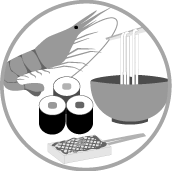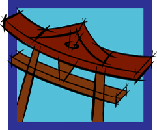 Food Food
While Japan’s diet isn’t
as healthy as it used to be, it’s still healthier than what most
Americans eat. Here are some of the foods you may encounter:
Curry
Curry was apparently brought
to Japan by the Dutch traders who came into Nagasaki during the Edo period
(1600-1867). Much of the curry in Japan is pretty mild, though it varies
from one restaurant to another. It’s usually eaten with rice and
thus referred to as “curry rice.” Not recommended for adults
is instant curry for children, which is actually more sweet than spicy.
Eel
Eel (unagi) is somewhat of
an acquired taste. I once hated it, but now I can’t get enough.
Eel are cut in two and roasted on skewers, or served on top of rice. Many
Japanese believe that unagi gives one stamina to withstand hot days, so
it’s a very popular dish during the summer. While the eels are supposedly
filleted, it pays to watch for small, sharp (though edible) bones while
eating. Even if you find that you enjoy unagi, you probably won’t
want to eat it very often, since it’s rather expensive.
Gyoza
Chinese dumplings with somewhat
of a crescent shape, often found at ramen restaurants or other shops that
purport to serve Chinese food. The outer wrapping is a wheat dough, and
the inside often contains shredded cabbage, mixed with meat or other things.
They may be served steamed, pan fried, or deep fried, and may be dipped
in hot pepper oil and vinegared soy sauce.
Okonomiyaki
Developed in
Osaka after World War II, okonomiyaki (“as-you-like-it grilled”)
has often been described as “Japanese pizza”. It consists
of meat, vegetables, and whatever else comes to mind, mixed with a batter
and then fried like a pancake. It’s topped with sôsu (a brown
sauce, not unlike steak sauce), dried seaweed, mayonnaise, ginger, shavings
of dried bonito (katsuobushi), or some combination of those.
Some restaurants bring you the ingredients and you can fry it yourself.
There are also variations on the recipe, such as Hiroshima style, where
yakisoba is sandwiched between a thin pancake
and a layer of fried eggs.
Pork Cutlet
Tonkatsu, a
breaded pork cutlet, is sometimes served on a plate with a mound of shredded
cabbage, and, if you like, then covered with sôsu. It’s also
served as katsudon, quickly cooked with a soup made of bullion,
egg, soy sauce, salt, onions, and sugar, and placed on top of a bowl of
rice.
Ramen
While ramen noodles originated
in China, there are some variations on the broth recipe that originated
in Japan. The best ramen is said to be Sapporo ramen, which is usually
served in what is essentially miso (fermented soybean) soup, though tonkotsu
(pig bone—the main ingredient) ramen from Kyushu also has its fans.
Paitanmen is ramen with cabbage and ginger; tantanmen is ramen served
in a spicy soup, which is considered to be a Chinese recipe.
Soba
Soba literally
means “buckwheat” which is what these noodles are made of.
Soba noodles may be served cold (mori-soba or zarusoba),
then dipped in soy sauce mixed with other seasonings, or hot, in a soup
with vegetables and perhaps some tempura.
The term “soba”
is a bit confusing because, at Chinese-style restaurants in Japan, it
refers to noodles which do not contain buckwheat. You may encounter yakisoba,
yellowish noodles that are fried with beef or pork, cabbage, and sôsu.
Quite good, but it’s not clear why it’s referred to as soba.
Spaghetti
You have probably never thought
of spaghetti as a Japanese dish. Just as American pizza is said to be
quite different from its Italian counterpart, the Japanese have taken
a number of liberties with spaghetti that never crossed the minds of Italians—or
Americans. There are countless restaurants in Japan devoted solely to
numerous varieties of spaghetti, from the familiar “meat sauce”
spaghetti, to spaghetti mixed with cod roe (tarako), mushrooms and dried
seaweed, or tuna or shrimp in white sauce. Spaghetti is routinely served
with Parmesean cheese and Tabasco Sauce on the side.
Just as Americans are surprised
when they order pizza in Italy, Japanese are seldom aware of how different
their spaghetti, often served in restaurants adorned with Italian flags,
is from its European ancestor. One Japanese told me how he had looked
forward to eating spaghetti with white sauce in Italy—and couldn’t
find any there.
Sukiyaki
You’ve surely heard
of this one, but may not know just what it is. It consists of thinly-sliced
beef, boiled together with various vegetables, tofu, and transparent noodles
called shirataki. As served at my in-laws’, all the ingredients
are boiled together on a gas-powered hotplate in the middle of the table.
Each person has a small bowl, containing a raw egg and some soy sauce,
in which we place the sukiyaki before eating.
Sushi & sashimi
Contrary to
what you may have heard, sushi is not merely “raw fish”. There
may be raw fish included in sushi, but the necessary ingredient for sushi
is lightly vinegared rice. The rice may be rolled around cucumber, fish,
or various other ingredients, with dried seaweed around the outside (makizushi);
in a molded mound topped with egg, boiled shrimp, raw fish, etc. (edomaezushi);
topped with some of these ingredients and served in a bowl (chirashizushi);
or in other forms.
Raw fish by
itself is known as sashimi. Sashimi is often served at sushi
restaurants. Sometimes non-fish types of sashimi are available, such as
beef or horsemeat.
Sushi places
can be rather expensive, but there are also kaiten (“revolving”)
sushi shops, where the prices are lower. The name refers to how the sushi
is served. Plates containing one or more pieces of various kinds of sushi
are placed on a sort of conveyer belt, which circles the sushi chef’s
area until someone at the surrounding counter picks it up. The color or
design of the plate indicates the price of the sushi on it.
The sushi on the conveyer belt
tends to be limited to the most popular kinds; other varieties can be
requested of the chef directly. There may also be bowls going around on
the belt with packages of fruit, desserts, or instant soup mix, and hot
water spigots on the counter for tea- or soup-making. Kaitenzushi is great
for a quick meal, but expect to spend at least ¥1000 before you start
to feel something approaching full.
Tempura
This is vegetables
and seafood deep-fried in batter. This dish was supposedly introduced
to Japan from Portugal late in the 16th century. Reportedly, the name
comes from the Latin tempora, referring to fried vegetables eaten
on days when meat was avoided for religious reasons. Often served on rice
(tendon) or in soba or udon noodles.
Udon
These are white noodles, thicker
than soba and made from wheat flour. They are usually served hot in many
of the same ways as soba. Udon are notorious for digesting very quickly;
you might feel full at first, but within a couple of hours you’re
hungrier than you were before you ate the udon!
Yakiniku
Grilled strips of beef, dipped
in a kind of barbecue sauce prior to grilling. Usually the grill is at
your table and you cook the meat (and some vegetables) yourself. Yakiniku
is often associated with Korean restaurants, but not all yakiniku restaurants
are labelled as Korean.
Yakisoba
See Soba.
Yakitori
Chunks of chicken skewered
on small wooden sticks and broiled over a fire. Often seen in tiny restaurants
along the street or in food stands at festivals.This short summary barely
scratches the surface of Japanese cuisine. The food in Japan is quite
varied, so you’re sure to find at least a few items you’ll
like.
If you want more information
on Japanese food, ...
View from
Japan home
|


 This page last updated
August 4, 2004
. E-mail Tim
This page last updated
August 4, 2004
. E-mail Tim